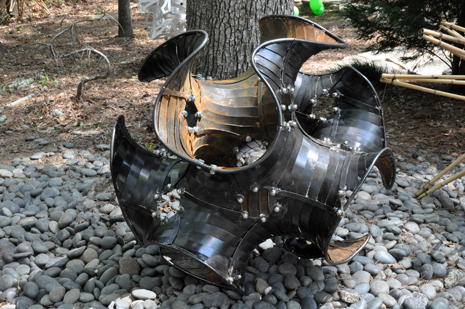
FAYETTEVILLE, Ark. – Chaim Goodman-Strauss, chair of the department of mathematical sciences at the University of Arkansas, recently collaborated with Fayetteville artist Eugene Sargent to create the Gyring Gyroid — a 120-pound hand-crafted steel sculpture that represents the complex gyroid surface discovered by a NASA physicist in 1970.
The gyroid is a surface in three-dimensional space that twists and turns repetitively and is shaped by the same forces that mold soap films.
The Gyring Gyroid is the third sculpture created by Goodman-Strauss and Sargent. Each of their pieces has been presented and installed at the Gathering for Gardner, a math, puzzle and magic conference in Atlanta. The biennial gathering is attended by 300 mathematicians, mathematical artists, puzzle makers and stage magicians — all devotees of longtime Scientific American columnist and author Martin Gardner. Gardner passed away in 2010 at age 95 after having written more than 70 books in his lifetime.
 Triamond, w/ Hexastix! |
“Through his Scientific American Mathematical Games columns and his scores of books on math, puzzles, science, philosophy, history, literature and stage magic, Gardner influenced generations and was the nucleus of a large community of very smart oddballs of all kinds,” Goodman-Strauss said. “Many very well known figures in their respective worlds regularly attend the gathering.”
Goodman-Strauss’ Gyring Gyroid was delivered to the Gathering for Gardner unassembled, consisting of 42 individual steel units. Attendees pitched in and assembled the sculpture together. The piece complements another sculpture unveiled at the gathering in 2008 called Double Triamond, w/ Hexastix! The gyroid and the triamond are closely related and could be intertwined. The hexastix of the double triamond would fit through the hexagonal holes of the gyroid.
 1 of N |
For the gathering in 2010 Goodman-Strauss and Sargent presented a sculpture called 1 of N that illustrates a space-filling curve.
“We obtained a curve that twists and turns and fills up every bit of the cube it sits in.” Goodman-Strauss said. “I never did work out exactly how many possible curves there were that fit our design criteria — something like 6.5 octillion. It’s about 40 inches tall, wide and deep and weighs about 700 pounds. It also jiggles.”
All three statues currently reside in the back yard of gathering organizer Tom Rodgers’ house. More images and detailed descriptions of the collaborations between Goodman-Strauss and Sargent are available at www.mathbun.com. Goodman-Strauss hosts a Martin Gardner-inspired Math Factor podcast that can be heard at www.mathfactor.uark.edu.
Contacts
Chaim Goodman-Strauss, chair, department of mathematical sciences
J. William Fulbright College of Arts and Sciences
479-575-3361, strauss@uark.edu